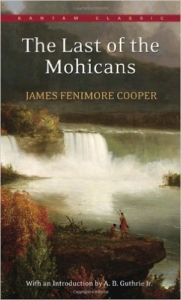 An American Classic Combining Action/Adventure and Discourses on Race Relations
An American Classic Combining Action/Adventure and Discourses on Race Relations
Author: James Fenimore Cooper
Set in the American frontier, during the bloody birth of a country and the guerrilla warfare of the French and Indian Wars (i.e. the Seven Years War), James Fenimore Cooper crafts an America action/adventure classic. Second in the Leatherstocking Tales, The Last of the Mohicans is a stand-alone novel featuring the classic brave adventurer/woodsman versus a cunning enemy with hostages at stake. Magua, a Huron Indian chief outcast for drunkenness, seeks vengeance against Colonel Munro by turning tail, going to the French, and attempting to kidnap the Colonel’s two daughters during their supposedly safe transport to Fort William Henry. A natural woodsman and superb scout with amazing gun slinging abilities, Hawkeye and his two Indian companions, Chingachgook and his son Uncas, the last remaining Mohican chief, hit the trail, ready to valiantly sacrifice their lives in order to rescue the captives. Along with these braves, Major Duncan Heyward, accompanied by a whimsical singing master, attempt to track down the Colonel’s daughters before Magua can unfurl the full horror of his vengeance.
Meanwhile, with all the scalping and bloodletting as a titillating background, the two Munro sisters are in the hands of a vengeful enemy. Alice Munro is the typical blond haired, fainting heroine. Cora, her mulatto sister, on the other hand proves both resourceful and stalwart, pushing aside the stereotype of the helpless female character lost in the wilderness.
The Last of the Mohicans is unique in that it merges adventure shenanigans with societal commentary and, in some cases, a forward thinking approach to race relations. Modern readers will still bristle at the inherent racism and all of the references to the Indians (i.e. calling them savages and such), yet Cooper’s actual message is lasting in that he was portraying a race being driven to extinction. Hawkeye himself boasts of his white blood, yet obviously regards the Delaware Indians (of which the Mohicans are a portion) as far superior and often boasts that his own skills are almost as good. Cora is partially black and the Colonel upbraids Duncan heartily for avoiding her affections due to racial prejudice. Even Duncan admits shame and the rightness of the Colonel’s testament that Cora is the superior daughter. Through the novel, Cora is held as a paragon and proves to be smarter and far savvier than her blond haired, blue eyed, and ultimately inept sister. In many instances, she is the equal of the men, and even Magua admits that her unshakable command is worthy of respect.
Of course, interspersed among the racial commentary and the picture of an evolving new society, there are battle scenes and escape scenes. The issue here is the sequencing of the serious commentary with the “fun” portion of the read. Hawkeye seems always at the ready to deliver a lecture, examining the differences between the whites and the Indians, regardless of circumstance or danger. With bullets hailing around him, he can casually lean over, dreamily talking his philosophy while readers hop with agitation, watching invading armies slaughter their way across the landscape as Hawkeye picks some epically bad timing for stalling the story mid-action to deliver long-winded philosophy.
Meanwhile, the action itself has a rote tinge. Interestingly, my dad listened to my audio book copy of Last of the Mohicans before I did. His rave reviews and general enthusiasm encouraged me to start on the book early, yet I never felt the excitement and tension he enthusiastically projected. Everything felt too much like an extreme manly-man adventure to me, complete with brave men talking of honor attempting to rescue the typical females in trouble. There is even a sequence where, upon discovering the women’s footprints, the rescuers pause, the men discussing how trekking the wilderness must be impossible with such tiny feet. PLEASE.
The characterization is subservient to the action and the themes Fenimore wants to examine. Everything is about the plot, but the characters themselves are caricatures, even Cora. No one feels fleshed out by motivations beyond idealism and even the professions of love between Duncan and the ever fainting Alice seem products of what we expect during an adventure, cowboys and Indians sort of story. The boy’s ultimate quest motif would be heart pounding, and I cannot deny that the action and adventure is hardcore throughout, yet I had difficulty getting involved beyond the mere intellectual curiosity to finally read an acclaimed classic.
In the conclusion, I see the quality and the elements which cause so much excitement in dedicated audiences. There is a reason this story has become a hallmark of American literature. Undeniably, it captures a transition in time, both wild and tragically brutal, and epitomizes the growth of a nation on the foundation of theft, yet the lack of an emotional attachment to the characters left me wooden, even during the shocking ending.
*A Note on Edition: I listed to the BrillianceAudio recorded version as read by Bill Weideman. Considering that there are whole conversations in French throughout Last of the Mohicans, the audio version is definitely the way to go. Keeping the unabridged text in-tact, BrillianceAudio translated the French conversations into English, greatly helping readers to follow the story. The flavor was still kept, as were some explicated French phrases, and the reading allowed readers to move seamlessly through the tale instead of stumbling on name pronunciation and conversations in multiple languages.
– Frances Carden
Follow my reviews on Twitter at: https://twitter.com/xombie_mistress
Follow my reviews on Facebook at: https://www.facebook.com/FrancesReviews/
- Book Vs Movie: The Shining - April 6, 2020
- Thankful For Great Cozy Mysteries - December 13, 2019
- Cozy Mysteries for a Perfect Fall - October 20, 2019


